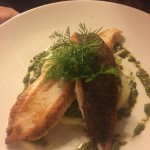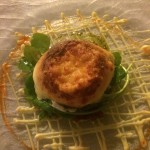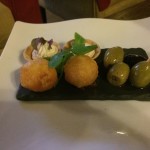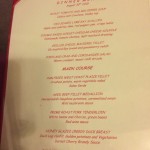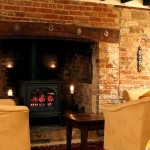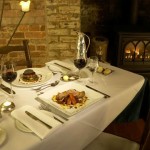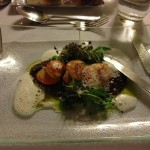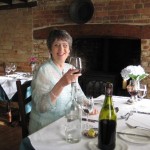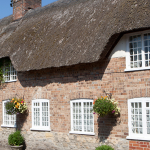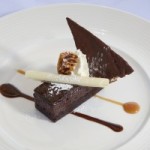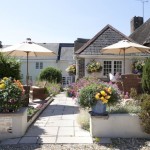Yarlbury Cottage is a smallish hotel and restaurant just outside Dorchester, one that aims for fine dining and should therefore be judged by those standards. You know this when you are offered a dainty plate of amuse bouches (olives, minute tartlets and cheesy balls) while picking from the menu in the cosy lounge, and once back in the lounge to drink your coffee are given charming home-made petits fours. Tempting perhaps to be won over by the “freebies” but a reviewer must be on his mettle and keep high standards!
Yarlbury came hugely recommended by Caroline, the owner of the Old Rectory, the fine guest house in which we were staying on the other side of Dorchester, which, given that Yarlbury Cottage also operates a high-quality boutique hotel is praise indeed. Jamie and Ariane Jones, owners of Yarlbury Cottage, “work incredibly hard”, says Caroline, and the Good Hotel Guide evidently agrees for it awarded Yarlbury the fitting soubriquet of Small Hotel of the Year 2015. This is their report:
In a hamlet in an ‘unspoilt part of England’, this small hotel/restaurant, a conversion of a row of 350-year-old thatched cottages, is run by Ariane and Jamie Jones. A family party celebrating a watershed birthday in 2014 commented on ‘perfect service from start to finish’. Another comment: ‘Ariane is a friendly, helpful host.’ The bedrooms, reached by a mishmash of corridors, have views of gardens or fields. They are decorated in simple, rural style; a large room had ‘pastel colours, pictures on three sides’. Housekeeping is ‘immaculate’. Jamie Jones, the chef, serves a ‘superb’ dinner in the oak-beamed restaurant in the oldest part of the building. ‘He produced delicious meals using local ingredients; pork tenderloin with Blue Vinny sauce and duck liver parfait were memorable.’ ‘The food was fresh and beautifully cooked.’ An ‘imaginative’ breakfast has ‘porridge made to your liking’; apricots in honey and cinnamon; three types of fish, free-range eggs cooked any way; black and white pudding with the full cooked. Yalbury Cottage is close to Thomas Hardy’s birthplace and his old schoolhouse. (Geoffrey Bignell, Tim Moorey, Sara Price)
I would have loved to check out the rooms and breakfast too, but on this occasion we took a taxi over and sampled the delights of the restaurant only.
The building is certainly what you would expect of an excellent restaurant in a rural idyl, being thatched and comfortably furnished. Warmed by open fires and proper wood-burning stoves, it has the ambience in which even the harshest of critics could soon be found toasting his toes and enjoying a refreshing aperitif of G&T, as did we – Bombay Sapphire on this occasion, though the only alternative was Gordons – alas, no stocks of “craft gins” that are popping up everywhere around London.
Perhaps this is slightly more old-school dining room with a touch of faded grandeur worthy of Hardy’s birthplace than up-to-the-minute fixtures and fittings. The mix-and-match crockery gives a vague air of eccentricity, but the place is none the worse for that – in the same way that pubs that have gained character over the years are infinitely superior to brewery makeovers, at least in part by giving the feeling of permanence. Or maybe that is the wrong word: how about “maturity”?
We certainly picked up a feeling of solidity and solidarity with the waiting staff, who certainly knew the menu and were friendly and helpful throughout, without being over-intrusive. They were notably lacking the sniffiness found in some top restaurants. You know what I mean: those where staff appear to believe themselves superior to the customers and lose no opportunity to demonstrate this belief.
From an extensive wine list I chose a half bottle of Château Le Pey Cru Bourgeois from the Médoc for me and a half bottle for her that completely escapes my memory. It must have been good since she drank it contentedly, though marks deducted from me for failing to picture her bottle. Mine proved a deep, smooth textured Bordeaux replete with rich blackcurrant fruit, and a perfect accompaniment to the beef fillet eaten later.
Since I had eaten scallops the previous night, my partner chose to start with them on this occasion, while I plumped for a twice-cooked Dorset cheddar soufflé, a dish I’ve cooked successfully but which retains the myth of being risky (done right, it isn’t) in preference to the very tempting Portland crab salad. If ever there was a good reason to select two or more starters, there was one.
The focal point of both dishes pleased and impressed (ie. the soufflé had precisely the texture one would expect and had not fallen flat), but I may have missed something in my artistic impression marks for the lattice grid of squirted “light mustard dressing” on which the soufflé was served and which didn’t really add to the dish. Perhaps it’s me but I never did get the fashion for fancy squiggles and splodges of sauces any more than I think it’s an improvement in visual design to have acres of white plate and a vertical mound of food in the middle.
So to the mains: pan-fried plaice fillet with crushed potato, “warm vegetable salad” and salsa verde for her; “aged beef fillet medallion”, horseradish dauphine potatoes, caramelised onion, wild mushroom sauce for me. Neither description would have failed the Trades Descriptions Act, but more relevant to this style of dining was that in each case the sum of the ingredients coalesced to form a greater, cohesive whole.
Admittedly you can’t go far wrong in that department with fine beef, onions, mushrooms and horseradish, but it shows admirable restraint on the part of Mr Jones that he chose not to throw in a bizarre array of added flavourings merely for effect, as is currently the wont at so many ambitious restaurants where talent is outweighed by showmanship – and for which so many critics are to blame.
None of the options at Yarlbury Cottage gave you that impression that Mr Jones is flying by the seat of his pants. On the contrary, he allows the quality of local raw materials to do the talking and to keep well within himself in fulfilment. In short, under-promise and over-deliver, of which I heartily approve – demonstrated by the fine colour and depth of flavour of the plaice and a tender fillet with just the right amount of pink showing.
One more test here: could I have done better in my own kitchen? The dauphinoise was perhaps below Millward’s finest, but other than that I am happy to concede Mr Jones a very fine touch. Neither did desserts let us down – an ensemble built around home-made chocolate brownie and a vanilla cheesecake with salted caramel and berries.
I wouldn’t say this was in the top ten best meals I’ve eaten, but it was very competent and does please the clientele, all of whom on this sample night looked highly contented with their evening’s dining. Judged on its merits, Yarlbury Cottage proved excellent, but I hope for their sake that the likes of the Gills and the Rayners avoid digging their sullied claws in. Go enjoy this dining experience when you are next in Dorset – and judge for yourself.






